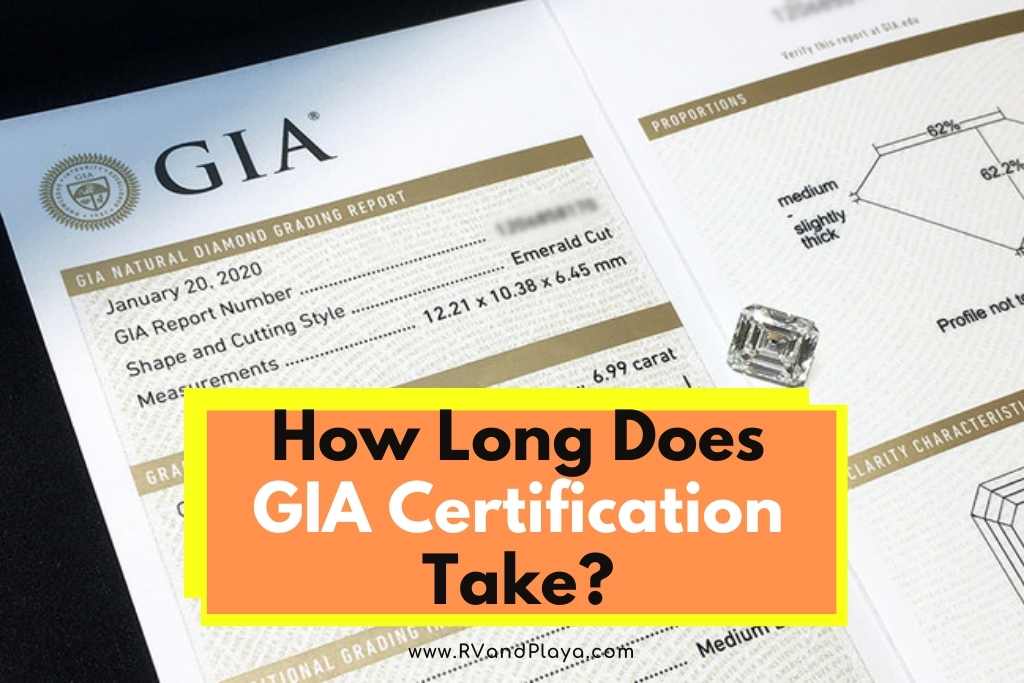GIA certification, or grading as the organization deems it, may take several weeks. Diamonds may be dropped off at a GIA laboratory or mailed in via your local jeweler. Once the diamond is accepted at the laboratory, it is put in a compartment of a clear tray with a lid and given a barcode identifier. Depending on the amount of inspection needed, the time it takes can vary.
In this article, we’re looking at the GIA certification for diamonds and how long it takes. We’re discussing the process and what you get out of it. Keep reading to find out how to have it done and if you should.
Table of Contents
What Is GIA Certification?
Let’s start by saying that GIA doesn’t actually certify anything. The term “GIA Certified” is something that’s been introduced in the commercial gemstone industry and has since stuck.
GIA is short for the Gemological Institute of America. This entity doesn’t sell gemstones, mine them, price them, or certify them. The GIA grades gemstones on quality. They don’t do anything else with them because it would result in a loss of objectivity.
The GIA does not give a certificate for diamonds and other gemstones. Graded gems have an associated report that gives all the details of the stones and descriptions of their quality.
Read also >> Are James Allen Diamonds GIA Certified? (Here Is Why)
Read also >> James Allen Lifetime Upgrade (All You Need To Know)
How Do You Submit a Gemstone for GIA Grading?
The GIA is headquartered in Carlsbad, California. There are nine other laboratory locations across the world. The U.S. has only two.
The GIA only grades gems that aren’t set in pieces of jewelry. For that reason, many jewelers have already had the gems graded before setting them. They may also sell unset diamonds and gemstones that have already been graded.
If you purchase a diamond you want graded or you have one that’s been handed down to you, you can physically take it to one of the laboratories if you happen to be close to one.
Most of us aren’t close to the GIA labs.
In that case, it’s best for you to work with a jeweler in your area to get your gemstone sent in for grading.
- Save an Average of $350* on Lab-Created Diamonds
- James Allen is the leader in online diamond sales
What Is the GIA Certification Process?
The 4Cs that are associated with diamonds came from the GIA grading process. They are–carat weight, cut quality, clarity, and color. The GIA grades diamonds on all of these factors.
One of the most important parts of the process is simply keeping interests separate. The GIA gemologists are able to maintain objectivity while inspecting gemstones because everything about the owner of the gem is kept anonymous. Each stone is given a barcode that tracks it through the grading process.
Up Front Testing
GIA’s initial testing is called GIA DiamondCheck. This step determines if the stone is a lab-grown diamond, a natural diamond, or not a diamond.
Additional testing is planned based on the results of the GIA DiamondCheck.
Measurements and Weights
Once the stones have been given identifiers, they are weighed and measured. An electronic micro-balance indicates a precise weight out to a fifth decimal.
The facet angles and proportions are measured with specialized equipment.
3-Cs Grading
Color, clarity, and cut are all graded separately. Multiple graders look at each stone for each of the three Cs.
The diamond’s color may look different depending on the environment in which it is viewed. For this reason, there is one standard viewing area for all diamonds. Several graders look at each diamond in that same viewing area.
They each render an opinion without knowing what anyone else has indicated. Once there are enough of the same opinion, the grade is given for color.
The clarity is also graded in a standard viewing environment and under 10x magnification. Clarity graders must look for unnatural treatments within the diamond. They may notice evidence of diamond filler or other tampering with imperfections.
This plays a role in the clarity grade. Opinions are collected and graphed. The final grade results from the majority opinions.
The final piece is the cut quality grade. This is only determined for round brilliant diamonds. The cut quality is based on the sparkle, its symmetry, how polished it appears, its brightness, and the weight ratio.
The Final GIA Grade
Once the final GIA grade is determined at the end of the inspection process, a report is generated that includes the following information:
- GIA Report Identification Number
- Carat Weight
- Measurements
- Shape
- Cut and Cutting Style
- Fluorescence
- Symmetry Details
- Inclusions and Blemish Descriptions and Diagram
- Evidence of Diamond Treatments
- Polish Description
- Clarity Grade
- Color Grade
How Long Does GIA Certification Take?
As you can see, the diamond grading process is extensive. It can take several weeks before the report is complete. It may also take far less time.
Some of what determines how long the grading process takes are the amount of business the GIA has coming in. The organization also suffers from staffing shortages at times.
There’s no full proof answer for how long it might take. It’s best to plan for several weeks and hope for the best.
Can You Order a Rush on GIA Certification?
You can order a rush on your diamond grading, if needed. There’s no guarantee but in some cases, you can get same day service for white diamonds and some colors.
The stone has to be received at a GIA laboratory by 10 AM.
There may be times when rush services aren’t available. Make sure to check with the specific location before placing a rush order.
Should All Diamonds Be GIA Certified?
The GIA certification helps with establishing the value of a stone. The GIA has a reputation for high quality grading. The grades are calculated with precision and unbiased opinions.
There are other certifications or grading entities, but GIA is the elite option. If you’re going to have the diamond graded, GIA is top-of-the-line.
You don’t have to have a diamond certified, though it may be a good idea if you wish to insure your stone or if you may sell it one day. It’s a decision you can make for yourself.
Will Your GIA Diamond Grade Report Have a Monetary Value Included?
The GIA grade report does not have a monetary value indicated anywhere. The purpose of the report is only to indicate the quality of the stone and its description.
That’s part of why it’s such a trustworthy report. There’s no conflict of interest or alternative agendas involved in the grading process.
Is the GIA Certification Used to Determine Monetary Value?
The monetary value of your diamond is determined based on various factors. A GIA certification report is one of the most influential factors in diamond valuation.
Since customers and jewelers know they can trust a GIA report, values of GIA certified diamonds are higher than some others.
GIA Certification FAQs
Are GIA certificates worth it?
GIA certificates are worth it because of the reputation the GIA carries within the industry. Jewelers know when they see a GIA graded diamond, they can trust the quality is what the report indicates it to be.
There is no questioning of the quality, making valuation easier.
How much does a GIA certificate cost?
The GIA reports are priced based on the carat weight of each stone. There are also different variations of reports you can order.
While all the variations include grades of the 4 Cs, the detail level and the method in which you get your report are different.
The lowest report fee is $20 in the U.S. and is the Diamond Focus Report. It’s a digital-only report that provides the least amount of extras, such as follow-up services and bonus information.
The Diamond Origin Report is the most expensive with a minimum fee of $75.
Can GIA certificates be faked?
Though some may try to fake a GIA report, it’s easy to check for the real report, just in case. Since all GIA reports include a unique identifying number on them, you can check the report by entering the number into the GIA Report Check website. You’ll know if the certificate is authentic then.
Can you sell a diamond without a certificate?
Yes, you can sell a stone without a GIA certificate. It may be tricky to get the money you want for it, though.
The GIA certificate vouches for the value of your diamond. Most jewelers or other buyers will be leery of purchasing a high-value stone without proof that it is what you say it is.
You may have to settle for less than what you wanted.
James Allen is the leader in online diamond sales. Their imaging technology is the same as inspecting a diamond with a jeweler's loupe. They have the largest exclusive loose diamond inventory online and fantastic prices.
They also have the nicest collection of lab created diamonds online. Save 10% off select lab grown diamonds and 25% off ring settings during limited time sale!
WHAT WE LOVE ABOUT THEM:
- No questions asked returns within 30 days of shipment. James Allen will send you a paid shipping label to return the ring.
- Lifetime Warranty
- Free International Shipping
- Free prong tightening, repolishing, rhodium plating and cleaning every 6 months
- Provide insurance appraisals
- One free resizing within 60 days of purchase
- Free ring inscriptions
- Best-in-class high quality imagery of all diamonds in stock
- 24/7 Customer Service
- Best-in-class packaging
The Bottom Line
A GIA certification may take just a week or could take up to several weeks. Regardless of the time it takes, diamonds that are 1-carat or more should be GIA certified.
Though it doesn’t set the value of the stone, it does help determine it and serves as evidence of its quality.
A GIA certified diamond is the elite standard of quality level integrity. Anyone in the gem and jewelry business knows the GIA is trustworthy and can bank on that reputation.
References
https://www.gia.edu/gem-lab-how-gia-grades-diamond
Recent Posts
Lindsey, do you know if James Allen diamonds are GIA certified? This is one of the questions our readers ask a lot. Well, we´ve got you covered. Some James Allen diamonds are GIA certified, but...
Do you know what James Allen's lifetime upgrade is? Well, you are at the perfect place to find the answer to such a question. James Allen is a well known supplier of quality jewelry, primarily...


